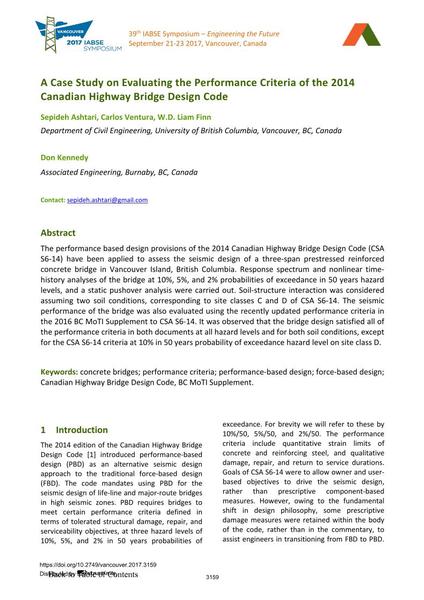A Case Study on Evaluating the Performance Criteria of the 2014 Canadian Highway Bridge Design Code

|
|
|||||||||||
Bibliografische Angaben
| Autor(en): |
Sepideh Ashtari
(Department of Civil Engineering, University of British Columbia, Vancouver, BC, Canada)
Carlos Ventura (Department of Civil Engineering, University of British Columbia, Vancouver, BC, Canada) W. D. Liam Finn (Department of Civil Engineering, University of British Columbia, Vancouver, BC, Canada) Don Kennedy (Associated Engineering, Burnaby, BC, Canada) |
||||
|---|---|---|---|---|---|
| Medium: | Tagungsbeitrag | ||||
| Sprache(n): | Englisch | ||||
| Tagung: | IABSE Symposium: Engineering the Future, Vancouver, Canada, 21-23 September 2017 | ||||
| Veröffentlicht in: | IABSE Symposium Vancouver 2017 | ||||
|
|||||
| Seite(n): | 3159-3166 | ||||
| Anzahl der Seiten (im PDF): | 8 | ||||
| Jahr: | 2017 | ||||
| DOI: | 10.2749/vancouver.2017.3159 | ||||
| Abstrakt: |
The performance based design provisions of the 2014 Canadian Highway Bridge Design Code (CSA S6-14) have been applied to assess the seismic design of a three-span prestressed reinforced concrete bridge in Vancouver Island, British Columbia. Response spectrum and nonlinear time- history analyses of the bridge at 10%, 5%, and 2% probabilities of exceedance in 50 years hazard levels, and a static pushover analysis were carried out. Soil-structure interaction was considered assuming two soil conditions, corresponding to site classes C and D of CSA S6-14. The seismic performance of the bridge was also evaluated using the recently updated performance criteria in the 2016 BC MoTI Supplement to CSA S6-14. It was observed that the bridge design satisfied all of the performance criteria in both documents at all hazard levels and for both soil conditions, except for the CSA S6-14 criteria at 10% in 50 years probability of exceedance hazard level on site class D. |
||||
| Stichwörter: |
Betonbrücke
|
||||
